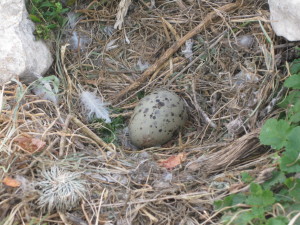Via Valencianos, Peñón de Ifach
During Easter week a couple contacted Bigtime Aventura to climb Via Valencianos, Peñón de Ifach in Calpe, Alicante, Spain. The Peñón is probably the most recognizable landmark on the entire Costa Blanca and is a top climbing destination for visitors (see a picture of the Peñón in the Alicante blog). This 332m mass of limestone rises abruptly from the Mediterranean Sea and majestically overlooks Calpe. The route called Via Valencianos, difficulty 5+, length 230m, and 8 pitches, is one of the easiest routes that scales this impressive buttress.
A nice perk to this route is that all of the belay anchors have been recently replaced. Now, each belay anchor has two bolts, each with a ring connected to the bolt hanger. This makes for a simple and quick anchor setup and the rings on the bolts allow for the possibility of descending by rappel from any of the anchors. All around this is a great choice for a safe and enjoyable first route on the Peñón de Ifach.
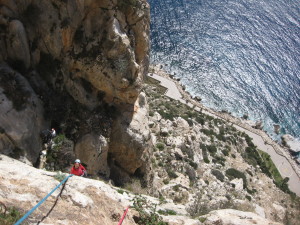
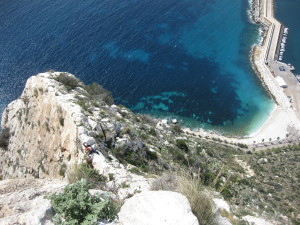
Pitches 1-2
The climbing and route finding are pretty straightforward. There are a few bolts on the first pitch that lead you off the ground and in the right direction but a few trad placements will improve your security. This pitch goes at a difficulty of about 3+/4. Once you reach the base of the large slab go to the bolted belay anchor to the left (the anchor to the right is for the route "Polvos Mágicos").
The second pitch wanders left through some bushes and ledges before making its way back right to a belay anchor directly above the first belay. It's advisable to continue to the right about 4m to the next bolted belay anchor. This pitch has a difficulty of grade 3. An alternative 2nd pitch is to climb the semi-bolted thin slab straight up from the first anchor. This is actually the second pitch of the route called "Direct de UBSA" and is 6a/+. A few small trad pieces help protect the runout second half of this pitch.
Again, once you reach the belay anchor it's actually advisable to continue about 4m to the right and use that anchor. But before doing so be mindful of other groups climbing the other routes that actually pertain to that anchor and obviously don't use that anchor if another group is on their way to it.
Pitch 3, the crux
The next pitch is considered the crux of the route at 5+. At least it used to be 5+. Now with thousands of ascents the 5+ crack section has become incredibly polished. You'd be better off trying to climb this part with ice skates. Start up the crack and protect it with one or two pieces of trad gear and then move into the crack on the right side (the crack to the left is harder and leads you onto a different route).
Luckily there is a bolt right where things become polished. Clip the bolt and go for it here if you want to try these moves free because you're well protected by the bolt. However, a little bit of A0 (pulling on the quickdraw) will surely speed things up and won't be discouraged. Continue up easier ground until you reach the belay anchor on a nice ledge.
Pitches 4-5
From here you see the beautiful long slab above which harbors the next two splendid pitches (pitches 4 and 5), both go at difficulty 4. As this is a well-traveled route you can see the path of the route as the rock has become somewhat polished, although there are so many positive holds that it doesn't detract from the quality of the pitches. Various bolts show the way. If you need more reinforcement there are lots of features that will happily gobble up trad gear.
At the top of pitch 5, the anchor rests just below the ridgeline. You can use this anchor or move 5m to the right and utilize the other bolted anchor which is a bit more comfortable. Again be courteous to other groups on other routes.
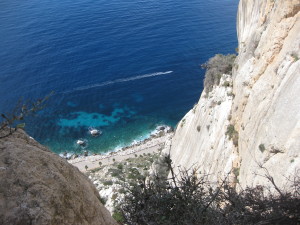
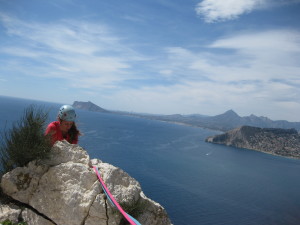
Pitches 6-8
Pitch 6 turns the corner of the buttress and climbs an amazing crack/dihedral line at a friendly grade of 4+. A bolt and a long fixed sling girth hitched around a rock bridge show the way up. After pulling around this corner things really ease the rest of the way. Continue up low angled broken ground until you find the bolted belay anchor. Pitch 7 eases even more (3) and a few pieces of trad protection will get you to the bolted anchor. Pitch 8, follow the easy gully (3) to the top of the Peñón to find the last bolted belay anchor.
Descent
Once at the top, enjoy the amazing views in all directions. If you'd like, you can hike up another 10 vertical meters to the true summit and a wonderful view down to Calpe and the salt flats. Follow the well groomed and polished hiking trail off the back side of the Peñón (first to the east and then to the north), through the tunnel, and back to the visitor center and then down to the marina and the parking.
Via Valencianos is a great introduction to climbing this wonderful mass of limestone. We've included a few pictures here that hopefully inspire you to climb this magnificent rock. Alternatively, contact us and we'd be happy to safely guide you up and give you all kinds of fun facts about the area.
A noteworthy tip is that because the Peñón is actually a massive sea cliff there are numerous seagulls in the area that make its extensive ledge systems and summit their home. This will be more than obvious as you approach the summit. Be careful not to disturb them and watch where you step as they build nests and lay eggs wherever they can find a soft patch between rocks. They have been known to dive bomb hikers to protect their area! Enjoy and we hope to see you soon!
